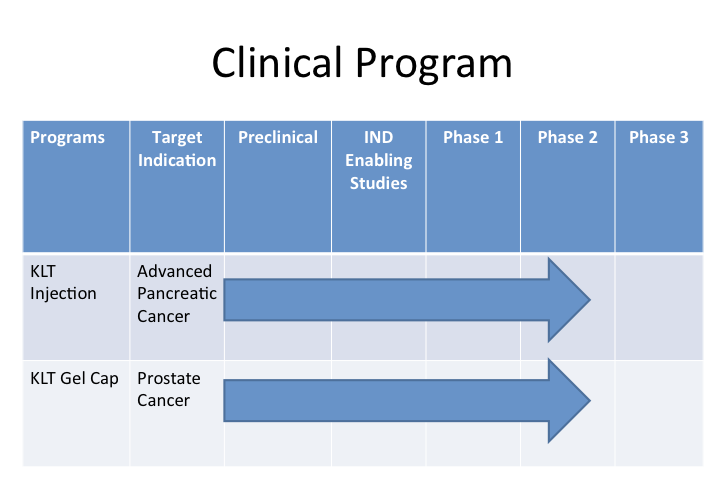KangLaiTe-USA is focused on discovering and developing natural therapies to improve the lives of people living with various cancers. Kanglaite Injection (KLTi), the lead candidate in the company’s clinical portfolio, has already benefited over one million patients in China, and is under study in the United States as a potential treatment for pancreatic cancer.

Ongoing Clinical Trials in the United States
A series of Phase IIB studies have been completed to evaluate the effect of Kanglaite Injection (KTLi) and Kanglaite Gel Cap (KLTc). These studies are in the following disease indications:
- Pancreatic cancer: A Phase IIB open label comparison of KLTi plus gemcitabine to gemcitabine has been completed in 2014 in patients with metastatic or locally invasive pancreatic cancer that was not amenable to surgical resection. In this study, trained home-infusion nurses administered KLTi doses. The study was performed through academic and community-based oncology centers in the United States. The primary endpoint was progression-free survival, with secondary endpoints of overall survival, objective response rate according to RECIST 1.1, and quality of life. In this study, patients in Cohort 1 (30 gm dosing regimen) documented improved PFS from 57.5 to 114 days (p=0.008), improved OS from 162 to 218 days, and improved one year survival rates: 9% versus 27%.
- Prostate Cancer: A Phase II open label comparative trial was completed, studying two doses of the oral form of Kanglaite (KLTc) in men who have a rising prostate-specific antigen (PSA) following definitive treatment. The study was performed in five academic cancer centers in the US. The primary endpoint was PSA doubling time (PSADT). A number of secondary endpoints, including PSA response and compliance, are also being evaluated.
Completed Clinical Trials in China
Completed phase III clinical trials in China have focused on response rate and performance status. A key Phase III licensing trial conducted in China compared tumor response rates in patients with advanced non-small cell lung cancer (NSCLC) receiving a standard chemotherapy regimen to patients receiving the same chemotherapy regimen plus Kanglaite Injection (KLTi). In this study, a tumor response rate of 45% was seen in the group receiving chemotherapy plus KLTi, compared to a tumor response rate of 21% in the chemotherapy-only group. Response was defined according to World Health Organization (WHO) criteria.
Shortly before the US Phase II study in pancreatic cancer patients, a very similar post marketing clinical trial was conducted in China in 2006-2009. Like the US trial, the Chinese study was a multi-center, randomized trial comparing KLTi plus gemcitabine to gemcitabine (G) monotherapy as first line treatment in patients with biopsy proven, Stage III or IVb pancreatic carcinoma.
In this Chinese trial the benefits of KLTi+G versus G monotherapy were observed in progression-free survival (PFS), median overall survival (OS) and objective response rate (ORR). In the intent-to-treat (ITT) analysis, the KLTi+G group had a median PFS of 201 days, substantially longer than the median PFS of 122.5 days in the G group. At one year, the percentage of patients who were progression free was 19.8% in the KLTi+G group versus 0% in the G group.
Longer median Overall Survival (OS) in the ITT population was also suggested in KLTi+G compared to G with median OS 262 days in the KLTi+G group versus 177 days in the G group. Of clinical importance, the objective response rate (ORR) for KLTi+G was 15% (6/40) and 0% (0/18) for G alone in the ITT population.
A recent Chinese literature search revealed more than 300 publications of preclinical and clinical research on KLTi in addition to the licensing studies conducted by Zhejiang Kanglaite Group. Although many of these publications are case descriptions by practicing oncologists, a number represent randomized, controlled trials.
The independent studies all reported an improvement in response rate when KLTi was added to a chemotherapy regimen, and statistical significance was reached in half of the studies despite their modest size and variable dosing regimens.
In addition to tumor response, the studies looked at the clinical benefit of the treatment to patients as determined by multiple performance criteria. All of the studies that evaluated performance status found a statistically significant improvement in the KLTi group. Many of the publications also document a decrease in other symptoms, including leucopenia, thrombocytopenia, pain, and nausea and vomiting. These data suggest that KLTi may have multiple benefits for patients, influencing both the tumor itself and the patient’s overall health.
Preclinical Studies
Kanglaite Injection has been shown to reduce the size of tumors in animal models. In studies in China, nude mice were injected with a range of tumor cell lines, including lung, pancreatic, and breast cancer cells, and then treated with KLTi. These mice typically show a significant reduction in tumor size relative to untreated animals.
Recent studies in the US have confirmed that KLTi is able to reduce the size of tumor xenografts in athymic nude mice compared to untreated controls. Array analyses and other studies have shed light on the cellular mechanism by which this occurs. Based primarily on breast cancer research at Johns Hopkins, two related mechanisms of action have been discovered: prevention of NFkB up-regulation and inhibition of fatty acid synthase.
For more information about these trials, please contact KangLaiTe-USA directly at .
